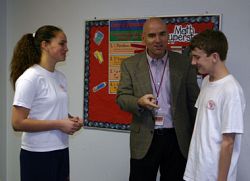Dr. Barman balances medicine with teaching math

SALT LAKE CITY — When Internist Doctor Tom Barman was in medical school he didn’t realize he was hiding a teacher inside. With a busy private practice and hospital duties Dr. Barman makes time to teach seventh and eighth grade mathematics at St. Vincent de Paul Elementary School one hour a day. The students enjoy Dr. Barman’s animated, fun approach to quadratic equations, statistics, and fractions. "It’s easy to get people excited about math when it’s presented at their level," Dr. Barman said in a Jan. 11 interview with the Intermountain Catholic. "Once you have them excited about the subject you can teach them more complex skills." Dr. Barman said he was so focused on being a doctor, and his career choice had such clear guideposts that teaching didn’t really occur to him. "As you progress in medical school, though, you do a ton of teaching. In fact, in Greek ‘doctor’ means ‘teacher.’" Dr. Barman sees beauty in numbers and how they impact each other. "In biology you have to learn such a fund of knowledge before you get to see the beauty, but in math and sports you get the see the beauty right away..." "I started teaching at St. Vincent’s when my daughter Stephanie was in middle school," he said. "Young people have to understand math in middle school or they’re sunk. I started tutoring her. I finally thought I might as well teach the class. That thought came to me as I sat in church one day." That was six years ago. Today, Stephanie is a student at Juan Diego Catholic High School and Dr. Barman is seeing her younger brother, Jake, through the same classes. A quick session of roshambo (rock, paper, scissors) brings a Thursday morning math class to its feet. His math classes fit hand in glove with the core curriculum used at St. Vincent’s school. What he teaches in math classes is related to what his students are learning in history and English classes, even Religion. Dr. Barman doesn’t allow any of his students to talk in negative terms about their own skills, and if they do, they spend time in the classroom penalty box. They have to come up with a secret phrase to get out of the penalty box. They have to say something outrageously positive about their math skills, like "Albert Einstein has nothing on me." He said medicine and teaching offer him a good balance. "Together, they keep me fresh. I especially like the first few minutes of the day in homeroom, which we spend in prayer, saying the Pledge of Allegiance, and in practicing S.A.T. questions. Today I talked to the students for a few minutes about how much I love to read." The doctor’s love of reading almost got him in trouble in medical school. Three weeks before final exams one year someone gave him a copy of J.R.R. Tolkein’s "Lord of the Rings." He couldn’t put the book down, and learned reading offered him relief from the stress of constant studying. Dr. Barman jokes about the volunteer hours he puts in at St. Vincent de Paul. "They couldn’t pay me enough to teach math, so I just volunteer. I am a full-time doctor and a one-hour-a-day volunteer teacher." Despite the high level of animated interaction that goes on in Dr. Barman’s classes, he emphasizes manners and expects his students to treat everyone with respect. He said he delights in those "light bulb" moments in class when a student who has struggled with a math concept suddenly "gets it." "Even the students understand the importance of the light bulb moments," he said. "Those moments are the opposite of ‘I can’t do this.’" It isn’t true that boys are better than girls at math, Dr. Barman insists, "but cultural influences can cause girls to concede their math skills. Biologically, boys and girls are equally capable of mastering math and science on the elementary or high school levels." Dr. Barman credits St. Vincent’s eighth grade teacher Kathleen O’Melia for making his time at the school so pleasant. "She’s a great teacher, and she teaches in a manner that is always clear." Dr. Barman and his family live in St. Thomas More Parish, but both he and his wife Carol can be found at St. Vincent’s during school hours. Carol is the school’s advancement director. "I have learned that the highest level of teaching is to make everything we teach seem simple. There are very few things in life that can’t be made more simple – simple to understand and simple to accomplish. That’s how we should look at all problems: make it simple," Dr. Barman said. He recalls a moment in the film "Apollo 13," when astronauts are struggling with a life or death problem in space, and another astronaut is trying to solve the problem in the simplest way back on earth. "The astronaut on earth says he’s going to ‘work the problem’ with pencil and paper. I tell the students to do the same thing. Their talents come out naturally without mystery, without depression, and without pain. By working the problem, they stay focused. "It’s the same in medicine. While you’re working the problem, you hope you get it right a lot of the time and wrong when it’s not so important."
© Copyright 2024 The Diocese of Salt Lake City. All rights reserved.

Stay Connected With Us